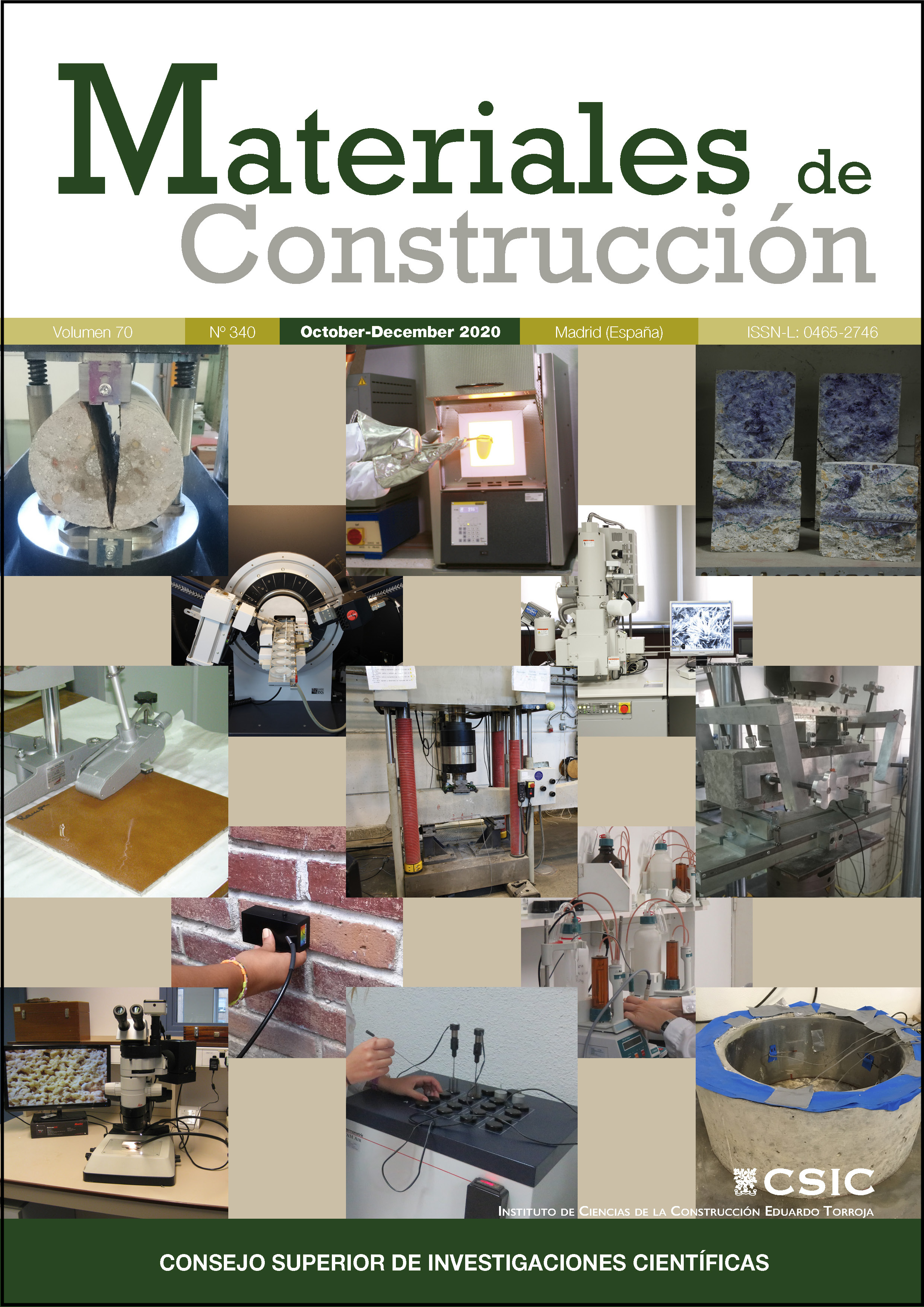Efecto de diferentes sílices de alta área superficial sobre la reología de pastas de cemento
DOI:
https://doi.org/10.3989/mc.2020.15719Palabras clave:
Reología, Trabajabilidad, Área superficial, Puzolana, Pasta de cementoResumen
Este trabajo estudia el efecto de la nanosílice (NS) sobre la reología de pastas de cemento por comparación con sílices de alta área superficial: humo de sílice (SF) y pirosílice (PS). Las pastas fueron fabricadas con diferentes relaciones agua-material cementante y sustituciones sólidas de sílice. Fueron ejecutados ensayos de demanda de agua, tiempo de fraguado y reología. Se encontró que la NS y SF disminuyen la viscosidad plástica, mientras que la PS la aumenta. Solo la PS tuvo efecto sobre el límite elástico. La NS presentó mayor disminución de la viscosidad, independientemente de su alta demanda de agua. Se concluyó que el comportamiento de las pastas con NS y SF es gobernado por el efecto de “rodamiento” de la sílice, por su grado de aglomeración y por su impacto en la fracción de sólidos. El comportamiento de las pastas con PS es gobernado por su capacidad de absorber agua.
Descargas
Citas
Kwan, A.K.H.; Li, Y. (2013) Effects of fly ash microsphere on rheology, adhesiveness and strength of mortar. Constr. Build. Mater. 42, 137-145. https://doi.org/10.1016/j.conbuildmat.2013.01.015
Jal, P.K.; Sudarshan, M.; Saha, A.; Patel, S.; Mishra, B.K. (2004) Synthesis and characterization of nanosilica prepared by precipitation method. Coll. Surf. A Physicochem. Eng. Asp. 240 [1-3], 173-178. https://doi.org/10.1016/j.colsurfa.2004.03.021
El Sokkary, T. M.; Assal, H. H.; Kandeel, A. M. (2004) Effect of silica fume or granulated slag on sulphate attack of ordinary portland and alumina cement blend. Ceram. Int. 30 [2], 133-138. https://doi.org/10.1016/S0272-8842(03)00025-7
Gutsch, A.; Krämer, M.; Michael, G.; Mühlenweg, H.; Pridöhl, M.; Zimmermann, G. (2002) Gas-Phase production of nanoparticles. KONA Powder Part. J. 20, 24-37. https://doi.org/10.14356/kona.2002008
Singh, L.P.; Karade, S.R.; Bhattacharyya, S.K.; Yousuf, M.M.; Ahalawat, S. (2013) Beneficial role of nanosilica in cement based materials - A review. Constr. Build. Mater. 47, 1069-1077. https://doi.org/10.1016/j.conbuildmat.2013.05.052
Björnström, J.; Martinelli, A.; Börjesson, L.; Panas, I.; (2004) Accelerating effects of colloidal nano-silica for beneficial calcium-silicate-hydrate formation in cement. Chem. Phys. Lett. 392 [1-3], 242-248. https://doi.org/10.1016/j.cplett.2004.05.071
Mendoza Reales, O.A.; Silva, E.C.C.M.; Paiva, M.D.M.; M.; Duda, P.; Toledo Filho, R.D. (2017) The role of surface area and compacity of nanoparticles on the rheology of cement paste 25.3. ACI Symp. Pub. 320, 25.1-25.14. https://www.concrete.org/publications/internationalconcreteabstractsportal/m/details/id/51701063.
Tobón, J. I.; Mendoza Reales, O.; Retrepo, O.J.; Borrachero, M.V. (2018) Effect of pyrogenic silica and nanosilica on Portland cement matrices. J. Mater. Civ. Eng. 30 [10], 1-10. https://doi.org/10.1061/(ASCE)MT.1943-5533.0002482
Mehdipour, I.; Khayat, K.H. (2018) Understanding the role of particle packing characteristics in rheo-physical properties of cementitious suspensions: A literature review. Constr. Build. Mater. 161, 340-353. https://doi.org/10.1016/j.conbuildmat.2017.11.147
Boukendakdji, O.; Kadri, E.H.; Kenai, S. (2012) Effects of granulated blast furnace slag and superplasticizer type on the fresh properties and compressive strength of selfcompacting concrete. Cem. Concr. Compos. 34 [4], 583-590. https://doi.org/10.1016/j.cemconcomp.2011.08.013
Park, C.K.; Noh, M.H.; Park, T.H. (2005) Rheological properties of cementitious materials containing mineral admixtures. Cem. Concr. Res. 35 [5], 842-849. https://doi.org/10.1016/j.cemconres.2004.11.002
Deng, H.; Li, H. (2018) Assessment of self-sensing capability of carbon black engineered cementitious composites. Constr. Build. Mater. 173, 1-9. https://doi.org/10.1016/j.conbuildmat.2018.04.031
Mendoza-Reales, O.A.; Arias Jaramillo, Y.P.; Ochoa Botero, J.C.; Delgado, C.A.; Quintero, J.H.; Toledo Filho, R.D. (2018) Influence of MWCNT/surfactant dispersions on the rheology of Portland cement pastes. Cem. Concr. Res. 107, 101-109. https://doi.org/10.1016/j.cemconres.2018.02.020
Quercia, G.; Hüsken, G.; Brouwers, H.J.H. (2012) Water demand of amorphous nano silica and its impact on the workability of cement paste. Cem. Concr. Res. 42 [2], 344-357. https://doi.org/10.1016/j.cemconres.2011.10.008
Norhasri, M.S.M.; Hamidah, M.S.; Fadzil, A.M. (2017) Applications of using nano material in concrete: A review. Constr. Build. Mater. 133, 91-97. https://doi.org/10.1016/j.conbuildmat.2016.12.005
Bowen, P. (2002). Particle size distribution measurement from millimeters to nanometers and from rods to platelets. J. Dispers. Sci. Technol. 23 [5], 631-662. https://doi.org/10.1081/DIS-120015368
Staiger, M.; Bowen, P.; Ketterer, J.; Bohonek, J. (2002) Particle size distribution measurement and assessment of agglomeration of commercial nanosized ceramic particles. J. Dispers. Sci. Technol. 23 [5], 619-630. https://doi.org/10.1081/DIS-120015367
Hidalgo, A.; Petit, S.; Domingo, C.; Alonso, C.; Andrade, C. (2007) Microstructural characterization of leaching effects in cement pastes due to neutralisation of their alkaline nature. Part I: Portland cement pastes. Cem. Concr. Res. 37 [1], 63-70. https://doi.org/10.1016/j.cemconres.2006.10.002
Srinivasan, S.; Barbhuiya, S.A.; Charan, D.; Pandey, S.P. (2010) Characterising cement-superplasticiser interaction using zeta potential measurements. Constr. Build. Mater. 24 [12], 2517-2521. https://doi.org/10.1016/j.conbuildmat.2010.06.005
de Larrard, F. (1999) Concrete mixture proportioning a scientific approach, E. & F.N. Spon, London. https://doi.org/10.1201/9781482272055
Banfill, P.F.G. (2006) Rheology of fresh cement and concrete. Rheol. Reviews 2006. 61-130.
Burneau, A.; Barres, O.; Gallas, J.P.; Lavalley, J.C. (1990) Comparative Study of the Surface Hydroxyl Groups of Fumed and Precipitated Silicas. 2. Chatracterization by infrared spectroscopy of the interacctions with water. Langmuir. 6 [8], 1364-1372. https://doi.org/10.1021/la00098a008
Xie, X-L.; Liu, Q-X.; Li, R.K-Y.; Zhou, X-P.; Zhang, Q-X.; Yu, Z-Z.; Mai, Y-W. (2004) Rheological and mechanical properties of PVC/CaCO3 nanocomposites prepared by in situ polymerization. Polymer. 45 [19], 6665-6673. https://doi.org/10.1016/j.polymer.2004.07.045
Asavapisit, S.; Fowler, G.; Cheeseman, C.R. (1997) Solution chemistry during cement hydration in the presence of metal hydroxide wastes. Cem. Concr. Res. 27 [8], 1249-1260. https://doi.org/10.1016/S0008-8846(97)00109-9
Publicado
Cómo citar
Número
Sección
Licencia
Derechos de autor 2020 Consejo Superior de Investigaciones Científicas (CSIC)

Esta obra está bajo una licencia internacional Creative Commons Atribución 4.0.
© CSIC. Los originales publicados en las ediciones impresa y electrónica de esta Revista son propiedad del Consejo Superior de Investigaciones Científicas, siendo necesario citar la procedencia en cualquier reproducción parcial o total.Salvo indicación contraria, todos los contenidos de la edición electrónica se distribuyen bajo una licencia de uso y distribución “Creative Commons Reconocimiento 4.0 Internacional ” (CC BY 4.0). Puede consultar desde aquí la versión informativa y el texto legal de la licencia. Esta circunstancia ha de hacerse constar expresamente de esta forma cuando sea necesario.
No se autoriza el depósito en repositorios, páginas web personales o similares de cualquier otra versión distinta a la publicada por el editor.


















